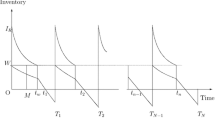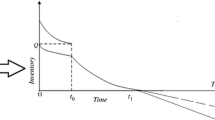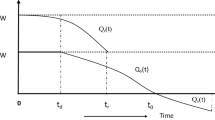Abstract
This paper deals with an inventory model for single non – instantaneous deteriorating items with two separate warehouses (one is Owned Warehouse and other is Rented Warehouse) having different preserving facilities. After some fixed period of time, inventory deteriorates in the two warehouses at different constant rates. Demand is assumed to be known and constant. In view of that the effect of inflation and time value of money over a finite planning horizon are employed in this study for optimizing the replenishment lot-size and the time interval simultaneously with the objective of minimizing total cost of the inventory system. Shortages are allowed and partially backlogged with a rate dependent on the duration of waiting time up to the arrival of next lot. The necessary and sufficient conditions for an optimal solution are characterized. In addition, an efficient algorithm is developed to determine the optimal policy, and the computational effort and time are small for the proposed algorithm. It is simple to implement, and our approach is illustrated through some numerical examples to demonstrate the application and the performance of the proposed methodology. Also, the effect of changes in the different parameters on the optimal total cost is graphically presented and the implications are discussed in detail.












Similar content being viewed by others
References
Hartely, V.R.: Operations research-A managerial emphasis. Good Year, California (1976)
Sarma, K.V.S.: A deterministic inventory model with two levels of storage and an optimum release rule. Opsearch 20, 175–180 (1983)
Sarma, K.V.S., Sastry, M.P.: Optimum inventory for systems with two levels of storage. Ind. Eng. J. 8, 12–19 (1988)
Pakkala, T.P.M., Achary, K.K.: A deterministic inventory model for deteriorating items with two warehouses and finite replenishment rate. Eur. J. Oper. Res. 57, 71–76 (1992)
Benkherouf, L.: A deterministic order level inventory model for deteriorating items with two storage facilities. Int. J. Prod. Econ. 48, 167–175 (1997)
Bhunia, A.K., Maity, M.: A two warehouse inventory model for deteriorating items with linear trend in demand and shortages. J. Oper. Res. Soc. 49, 287–292 (1998)
Lee, C., Ma, C.: Optimal inventory policy for deteriorating items with two-warehouse and time-dependent demands. Prod. Plan. Control 11, 689–696 (2000)
Yang, H.L.: Two-warehouse inventory models for deteriorating items with shortages under inflation. Eur. J. Oper. Res. 157, 344–356 (2004)
Yang, H.L.: Two-warehouse partial backlogging inventory models for deteriorating items under inflation. Int. J. Prod. Econ. 103, 362–370 (2006)
Hsieh, T.P., Dye, C.Y., Ouyang, L.Y.: Determining optimal lot size for a two-warehouse system with deterioration and shortages using net present value. Eur. J. Oper. Res. 191, 182–192 (2008)
Lee, C.C., Hsu, S.L.: A two-warehouse production model for deteriorating inventory items with time-dependent demands. Eur. J. Oper. Res. 194, 700–710 (2009)
Liang, Y., Zhou, F.: A two-warehouse inventory model for deteriorating items under conditionally permissible delay in payment. Appl. Math. Model. 35, 2221–2231 (2011)
Yang, H.L.: Two-warehouse partial backlogging inventory models with three-parameter Weibull distribution deterioration under inflation. Int. J. Prod. Econ. 138, 107–116 (2012)
Sett, B.K., Sarkar, B., Goswami, A.: A two-warehouse inventory model with increasing demand and time varying deterioration. Sci. Iran. E. 19, 1969–1977 (2012)
Agrawal, S., Banerjee, S., Papachristos, S.: Inventory model with deteriorating items, ramp-type demand and partially backlogged shortages for a two warehouse system. Appl. Math. Model. 37, 8912–8929 (2013)
Yang, H.L., Chang, C.T.: A two-warehouse partial backlogging inventory model for deteriorating items with permissible delay in payment under inflation. Appl. Math. Model. 37, 2717–2726 (2013)
Lou, K.R., Wang, W.C.: A comprehensive extension of an integrated inventory model with ordering cost reduction and permissible delay in payments. Appl. Math. Model. 37, 4709–4716 (2013)
Guchhaita, P., Maiti, M.K., Maiti, M.: Two storage inventory model of a deteriorating item with variable demand under partial credit period. Appl. Soft Comput. 13, 428–448 (2013)
Ouyang, L.Y., Chang, C.T.: Optimal production lot with imperfect production process under permissible delay in payments and complete backlogging. Int. J. Prod. Econ. 144, 610–617 (2013)
Bhunia, A.K., Jaggi, C.K., Sharma, A., Sharma, R.: A two-warehouse inventory model for deteriorating items under permissible delay in payment with partial backlogging. Appl. Math. Comput. 232, 1125–1137 (2014)
Singh, T., Pattnayak, H.: A two-warehouse inventory model for deteriorating items with linear demand under conditionally permissible delay in payment. Int. J. Manag. Sci. Eng. Manag. 9, 104–113 (2014)
Jaggi, C.K., Pareek, S., Khanna, A., Sharma, R.: Credit financing in a two-warehouse environment for deteriorating items with price-sensitive demand and fully backlogged shortages. Appl. Math. Model. 38, 5315–5333 (2014)
Ghare, P.M., Schrader, G.H.: A model for exponentially decaying inventory system. Int. J. Prod. Res. 21, 449–460 (1963)
Philip, G.C.: A generalized EOQ model for items with weibull distribution. AIIE Trans. 6, 159–162 (1974)
Deb, M., Chaudhuri, K.S.: An EOQ model for items with finite rate of production and variable rate of deterioration. Opsearch 23, 175–181 (1986)
Goyal, S.K., Giri, B.C.: Recent trends in modeling of deteriorating inventory. Eur. J. Oper. Res. 134, 1–16 (2001)
Wu, K.S., Ouyang, L.Y., Yang, C.T.: An optimal replenishment policy for non-instantaneous deteriorating items with stock-dependent demand and partial backlogging. Int. J. Prod. Econ. 101, 369–384 (2006)
Ouyang, L.Y., Wu, K.S., Yang, C.T.: A study on an inventory model for non-instantaneous deteriorating items with permissible delay in payments. Comput. Ind. Eng. 51, 637–651 (2006)
Liao, J.: An EOQ model with non instantaneous receipt and exponential deteriorating item under two-level trade credit. Int. J. Prod. Econ. 113, 852–861 (2008)
Uthayakumar, R., Geetha, K.V.: A replenishment policy for Non-instantaneous deteriorating inventory system with partial backlogging. Tamsui Oxf. J. Math. Sci. 25, 313–332 (2009)
Chung, K.J.: A complete proof on the solution procedure for non-instantaneous deteriorating items with permissible delay in payment. Comput. Ind. Eng. 56, 267–273 (2009)
Geetha, K.V., Uthayakumar, R.: Economic design of an inventory policy for non-instantaneous deteriorating items under permissible delay in payments. J. Comput. Appl. Math. 233, 2492–2505 (2010)
Chang, C.T., Teng, J.T., Goyal, S.K.: Optimal replenishment policies for non-instantaneous deteriorating items with stock-dependent demand. Int. J. Prod. Econ. 123, 62–68 (2010)
Maihami, R., Abadi, I.N.K.: Joint control of inventory and its pricing for non-instantaneously deteriorating items under permissible delay in payments and partial backlogging. Math. Comput. Model. 55, 1722–1733 (2012)
Maihami, R., Kamalabadi, I.N.: Joint pricing and inventory control for non-instantaneous deteriorating items with partial backlogging and time and price dependent demand. Int. J. Prod. Econ. 136, 116–122 (2012)
Dye, C.Y.: The effect of preservation technology investment on a non-instantaneous deteriorating inventory model. Omega 41, 872–880 (2013)
Ghoreishi, M., Mirzazadeh, A., Weber, G.W.: Optimal pricing and ordering policy for non-instantaneous deteriorating items under inflation and customer returns. Optimization 63, 1785–1804 (2014)
Kumar, N., Singh, S.R.: Effect of salvage value on a two-warehouse inventory model for deteriorating items with stock-dependent demand rate and partial backlogging. Int. J. Oper. Res. 19, 479–496 (2014)
Ghoreishi, M., Mirzazadeh, A., Weber, G.W., Kamalabadi, I.N.: Joint pricing and replenishment decisions for non-instantaneous deteriorating items with partial backlogging, inflation- and selling price-dependent demand and customer returns. J. Ind. Manag. Optim. 11, 933–949 (2014)
Maihami, R., Karimi, B.: Optimizing the pricing and replenishment policy for non-instantaneous deteriorating items with stochastic demand and promotional efforts. Comput. Oper. Res. 51, 302–312 (2014)
Tat, R., Taleizadeh, A.A., Esmaeili, M.: Developing economic order quantity model for non- instantaneous deteriorating items in vendor-managed inventory (VMI) system. Int. J. Syst. Sci. 46, 1257–1268 (2015)
Buzacott, J.A.: Economic order quantities with inflation. Oper. Res. Q. 26, 553–558 (1975)
Bierman, H., Thomas, J.: Inventory decisions under inflationary conditions. Decis. Sci. 8, 151–155 (1977)
Misra, R.B.: A note on optical inventory management under inflation. Nav. Res. Logist. Q. 26, 161–165 (1979)
Data, T.K., Pal, A.K.: Effects of inflation and time value of money on an inventory model with linear time dependent demand rate and shortages. Eur. J. Oper. Res. 52, 326–333 (1991)
Sarker, B.R., Pan, H.: Effects of inflation and time value of money on order quantity and allowable shortage. Int. J. Prod. Econ. 34, 65–72 (1994)
Bose, S., Goswami, A., Chaudhuri, K.S.: An EOQ model for deteriorating items with linear time-dependent demand rate and shortages under inflation and time discounting. J. Oper. Res. Soc. 46, 771–782 (1995)
Hariga, M.: Effects of inflation and time value of money on an inventory model with time dependent demand rate and shortages. Eur. J. Oper. Res. 81, 512–520 (1995)
Chung, K.J.: Optimal ordering time interval taking account of time value. Prod. Plan. Control 7, 264–267 (1996)
Ray, J., Chaudhuri, K.S.: An EOQ model with stock-dependent demand, shortage, inflation and time discounting. Int. J. Prod. Econ. 53, 171–180 (1997)
Hou, K.L., Lin, L.C.: An EOQ model for deteriorating items with price- and stock-dependent selling rates under inflation and time value of money. Int. J. Syst. Sci. 37, 1131–1139 (2006)
Mirzazadeh, A., Seyyed Esfahani, M.M., Fatemi Ghomi, S.M.T.: An inventory model under uncertain inflationary conditions, finite production rate and inflation-dependent demand rate for deteriorating items with shortages. Int. J. Syst. Sci. 40, 21–31 (2009)
Thangam, A., Uthayakumar, R.: An inventory model for deteriorating items with inflation induced demand and exponential partial backorders–a discounted cash flow approach. Int. J. Manag. Sci. Eng. Manag. 5, 170–174 (2010)
Valliathal, M., Uthayakumar, R.: The production - inventory problem for ameliorating/ deteriorating items with Non-linear shortage cost under inflation and time discounting. Appl. Math. Sci. 4, 289–304 (2010)
Sarkar, B., Moon, I.: An EPQ model with inflation in an imperfect production system. Appl. Math. Comput. 217, 6159–6167 (2011)
Tolgari, J.T., Mirzazadeh, A., Jolai, A.: An inventory model for imperfect items under inflationary conditions with considering inspection errors. Comput. Math. Appl. 63, 1007–1019 (2012)
Guria, A., Das, B., Mondal, S., Maiti, M.: Inventory policy for an item with inflation induced purchasing price, selling price and demand with immediate part payment. Appl. Math. Model. 37, 240–257 (2013)
Gilding, B.H.: Inflation and the optimal inventory replenishment schedule within a finite planning horizon. Eur. J. Oper. Res. 234, 683–693 (2014)
Chang, H.J., Dye, C.Y.: An EOQ model for deteriorating items with time varying demand and partial backlogging. J. Oper. Res. Soc. 50, 1176–1182 (1999)
Dye, C.Y., Ouyang, L.Y., Hsieh, T.P.: Deterministic inventory model for deteriorating items with capacity constraint and time-proportional backlogging rate. Eur. J. Oper. Res. 178, 789–807 (2007)
Park, K.S.: Inventory models with partial backorders. Int. J. Syst. Sci. 13, 1313–1317 (1982)
Wang, S.P.: An inventory replenishment policy for deteriorating items with shortages and partial backlogging. Comput. Oper. Res. 29, 2043–2051 (2002)
Min, J., Zhou, Y.W.: A perishable inventory model under stock-dependent selling rate and shortage-dependent partial backlogging with capacity constraint. Int. J. Syst. Sci. 40, 33–44 (2009)
Tripathy, C.K., Pradhan, L.M.: An EOQ model for Weibull deteriorating items with power demand and partial backlogging. Int. J. Contemp Math. Sci. 5, 1895–1904 (2010)
Yang, H.L.: A partial backlogging production-inventory lot-size model for deteriorating items with time-varying production and demand rate over a finite time horizon. Int. J. Syst. Sci. 42, 1397–1407 (2011)
Roy, M.D., Sana, S.S., Chaudhuri, K.S.: An economic order quantity model of imperfect quality items with partial backlogging. Int. J. Syst. Sci. 42, 1409–1419 (2011)
Cheng, M., Zhang, B., Wang, G.: Optimal policy for deteriorating items with trapezoidal type demand and partial backlogging. Appl. Math. Model. 35, 3552–3560 (2011)
Sarkar, T., Ghosh, S.K., Chaudhuri, K.S.: An optimal inventory replenishment policy for a deteriorating item with time-quadratic demand and time-dependent partial backlogging with shortages in all cycles. Appl. Math. Comput. 218, 9147–9155 (2012)
Ahmed, M.A., Al-Khamis, T.A., Benkherouf, L.: Inventory models with ramp type demand rate, partial backlogging and general deterioration rate. Appl. Math. Comput. 219, 4288–4307 (2013)
Sarkar, B., Sarkar, S.: An improved inventory model with partial backlogging, time varying deterioration and stock-dependent demand. Econ. Model. 30, 924–932 (2013)
Taleizadeh, A.A., Pentico, D.W.: An economic order quantity model with a known price increase and partial backordering. Eur. J. Oper. Res. 228, 516–525 (2013)
Taleizadeh, A.A., Pentico, D.W., Jabalameli, M.S., Aryanezhad, M.: An EOQ model with partial delayed payment and partial backordering. Omega 41, 354–368 (2013)
Tan, Y., Weng, M.X.: A discrete-in-time deteriorating inventory model with time-varying demand, variable deterioration rate and waiting-time-dependent partial backlogging. Int. J. Syst. Sci. 44, 1483–1493 (2013)
Chowdhury, R.R., Ghosh, S.K., Chaudhuri, K.S.: An order-level inventory model for a deteriorating item with time-quadratic demand and time-dependent partial backlogging with shortages in All cycles. Am. J. Math. Manag. Sci. 33, 75–97 (2014)
Ghoreishi, M., Weber, G.W., Mirzazadeh, A.: An inventory model for non-instantaneous deteriorating items with partial backlogging, permissible delay in payments, inflation- and selling price-dependent demand and customer returns. Ann. Oper. Res. 226, 221–238 (2014)
Taleizadeh, A.A.: An EOQ model with partial backordering and advance payments for an evaporating item. Int. J. Prod. Econ. 155, 185–193 (2014)
Al-Khamis, T.M., Benkherouf, L., Omar, M.: Optimal policies for a finite-horizon batching inventory model. Int. J. Syst. Sci. 45, 2196–2202 (2014)
Pal, S., Mahapatra, G.S., Samanta, G.P.: A production inventory model for deteriorating item with ramp type demand allowing inflation and shortages under fuzziness. Econ. Model. 46, 334–345 (2015)
Acknowledgments
The authors would like to thank the editors and anonymous reviewers for their valuable and constructive comments, which have led to a significant improvement in the manuscript. The research work is supported by DST INSPIRE, Ministry of Science and Technology, Government of India under the grant no. DST/INSPIRE Fellowship/2011/413B dated 02.12.2014.
Author information
Authors and Affiliations
Corresponding author
Rights and permissions
About this article
Cite this article
Palanivel, M., Uthayakumar, R. Two-warehouse inventory model for non-instantaneous deteriorating items with partial backlogging and inflation over a finite time horizon. OPSEARCH 53, 278–302 (2016). https://doi.org/10.1007/s12597-015-0235-4
Accepted:
Published:
Issue Date:
DOI: https://doi.org/10.1007/s12597-015-0235-4




